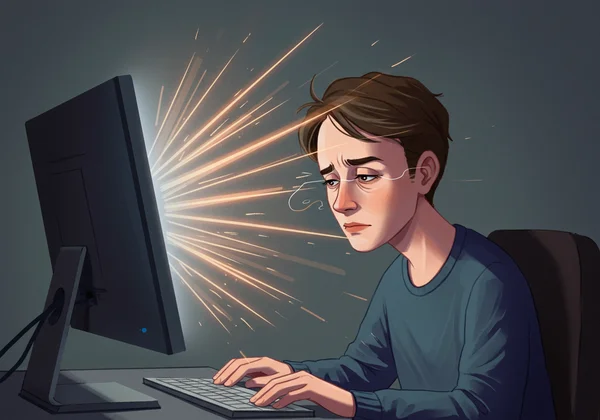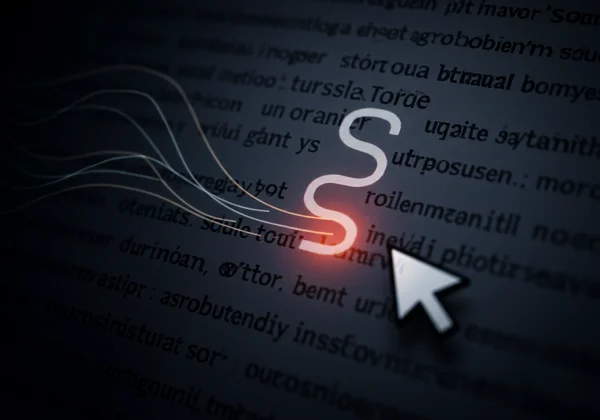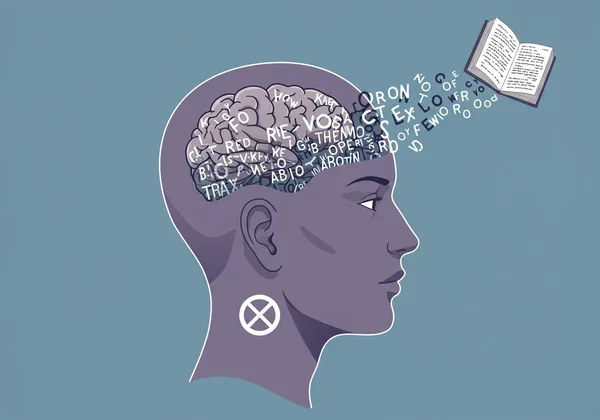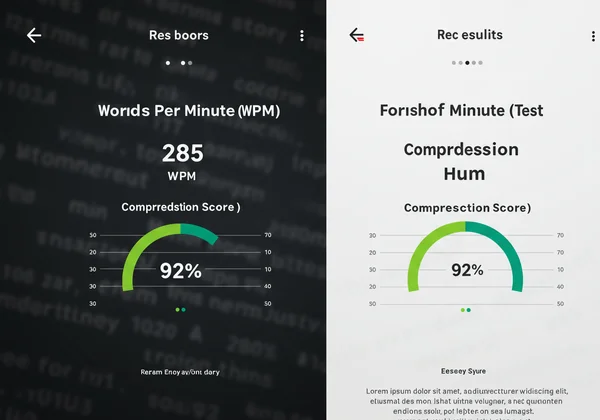Reading Speed Test on Screens: A Guide to Increase Your WPM
Staring at a screen, you have endless reports to read, but your eyes feel tired, and the words start to blur. You're not alone. In our digital-first world, professionals and students spend hours a day reading on screens, yet many find it slower and more exhausting than reading a physical book. This isn't just a feeling; reading on a screen is scientifically more demanding on your brain and eyes. But does reading on a screen slow you down? For most people, the answer is yes, but it doesn't have to be a permanent handicap.
This guide will break down why digital reading is challenging and provide concrete, easy-to-implement strategies to combat digital fatigue. We'll help you increase your reading speed without sacrificing comprehension. By applying these techniques, you can transform your screen time from a draining task into an efficient one. Before you start, you might want to establish a baseline by taking a reading speed test to see where you currently stand.
Why Is Your Digital Reading Speed Slower?
Before jumping into solutions, understanding the root cause of the problem is essential. Your digital reading speed is impacted by a combination of physiological and cognitive factors that are unique to screens. Recognizing these challenges is the first step toward overcoming them.
Understanding Digital Eye Strain and Its Causes
The most common complaint associated with screen reading is digital eye strain, also known as Computer Vision Syndrome. This isn't a single issue but a collection of symptoms, including tired eyes, headaches, blurred vision, and dry eyes. It happens for several reasons:
-
Glare and Reflections: Screens produce glare, forcing your eyes to work harder to focus on the text.
-
Pixelated Text: Unlike the crisp, solid ink on a page, letters on a screen are made of tiny dots (pixels) with less defined edges. Your eyes must constantly refocus to maintain clarity.
-
Reduced Blinking: Studies show that people blink up to 66% less often when staring at a screen. This leads to dry, irritated eyes, which can significantly disrupt your reading flow and comfort.

The Cognitive Load: Scrolling vs. Physical Pages
When you read a physical book, you have a strong sense of geography. You can feel how far you've read and how much is left. This spatial awareness helps your brain create a mental map of the content, which aids in comprehension and recall.
Screens disrupt this process. The act of scrolling creates a continuous, placeless stream of text. Your brain loses the physical anchors it uses to structure information, increasing the cognitive load. This means more mental energy is spent navigating the page and less is available for processing and understanding the material. The constant need to reorient yourself after each scroll can break your concentration and slow down your reading pace.
The Constant Battle Against Digital Distractions
A computer or phone is a gateway to endless distractions. Notifications pop up, dozens of tabs beckon, and the temptation to check email or social media is always just a click away. This environment of constant interruption makes it difficult to achieve the deep focus required for efficient reading.
Every time you switch your attention, even for a moment, you have to find your place again and ramp back up to your previous reading speed. This fragmentation of focus is a major barrier to improving your words-per-minute (WPM) count and absorbing information effectively. Overcoming this requires both environmental control and disciplined reading habits, which you can measure with our online tool.
5 Actionable Tips to Read Faster on a Computer
Understanding the 'why' is half the battle. Now, let's arm you with the techniques to win it. These are not magic tricks but practical, science-backed techniques you can start using today to read faster on a computer and make your digital reading experience more comfortable and productive.
Optimize Your Display for Comfortable Reading
Your reading environment significantly impacts your speed and comfort. A poorly configured display will cause eye strain and slow you down before you even finish the first paragraph.
- Adjust Brightness and Contrast: Your screen brightness should match the ambient light in your room. If it's too bright or too dark, your eyes will strain. Use a high-contrast mode (black text on a white or slightly off-white background) for maximum clarity.
- Increase Font Size: Don't be afraid to zoom in. Trying to read tiny text is one of the quickest ways to cause eye fatigue. Find a size that feels comfortable and allows you to read without squinting.
- Use "Reader Mode": Most modern web browsers have a "Reader Mode" that strips away ads, sidebars, and other distracting elements, leaving you with clean, readable text.
- Follow the 20-20-20 Rule: Every 20 minutes, look at something 20 feet away for at least 20 seconds. This simple exercise relaxes your eye muscles and helps prevent strain.
Use a Pointer to Guide Your Focus
One of the most effective speed-reading techniques is using a pacer, and you already have one built into your computer: your mouse cursor. When you read, your eyes naturally make small, jerky movements and often regress to re-read words. This slows you down considerably.
By moving your cursor smoothly along the line of text as you read, you force your eyes to follow at a steady pace. This simple action minimizes regressions and keeps your momentum going forward. Start at a comfortable pace and gradually increase the speed of your cursor as you get more confident. You might be surprised at how much faster you can read when your eyes have a clear path to follow. Why not test this technique right after reading this section?

Master Digital Skimming and Scanning Techniques
Not every word on a page is equally important. Professionals and students buried in documents and research papers need to extract key information quickly. This is where skimming and scanning become invaluable skills.
- Skimming: This is a method of fast reading to get the general idea of a text. Instead of reading every word, focus on headings, subheadings, the first sentence of each paragraph, and any bolded or italicized text. This gives you a high-level overview in a fraction of the time.
- Scanning: Use this technique when you're looking for a specific piece of information, like a name, date, or keyword. Let your eyes drift quickly over the page, ignoring everything else until you spot what you're looking for.
Reduce Subvocalization
Subvocalization is the habit of silently saying each word in your head as you read. While it helps with comprehension for difficult texts, it creates a bottleneck: you can only read as fast as you can speak. The average speaking speed is around 150-200 WPM, which is far below your brain's potential processing speed.
To read faster, you need to quiet that inner voice. Try these methods:
-
Focus on Blocks of Words: Instead of seeing individual words, train your eyes to see groups of 3-4 words at a time. This makes it harder for your brain to pronounce each one.
-
Use a Distraction: Gently chewing gum or humming quietly can occupy the mental resources used for subvocalization, freeing up your mind to read faster.
-
Pace Yourself: Using your cursor as a pointer, as mentioned earlier, can help you move faster than your inner voice can keep up.

Control Your Pace with Reading Apps and Extensions
There are many digital tools designed to help you practice and increase your reading pace. Some use a method called Rapid Serial Visual Presentation (RSVP), which flashes one word at a time in the center of the screen, eliminating the need for eye movement. Other apps act as teleprompters, scrolling text at a set speed.
While these can be excellent training aids, remember that the ultimate goal is effective reading—speed with comprehension. After using these apps for practice, it's crucial to benchmark your real-world performance. A comprehensive wpm test that includes comprehension questions is the best way to see if your training is paying off.
Stop Guessing, Start Measuring: Test Your New Skills Now
Knowledge is only potential power. Action is real power. You have the techniques—now prove their effectiveness. These strategies are most effective when you track your improvement. Take our free, science-backed Reading Speed Test to get a hard number on your progress! It measures both your words-per-minute and comprehension, giving you a true picture of your reading efficiency.

Frequently Asked Questions About Reading on a Screen
Does reading on a screen actually slow you down?
Yes, for most people, studies indicate that reading on a screen can be up to 30% slower than reading on paper. This is due to a combination of factors, including digital eye strain from screen glare and pixelated text, and the increased cognitive load from scrolling, which disrupts our ability to form a mental map of the content.
What is the average reading WPM for an adult on a computer?
While the average reading speed for an adult on paper is about 200-250 WPM, it's often slightly lower on a computer, typically falling in the 180-220 WPM range. However, a "good" speed is one where you can maintain high comprehension. Speed without understanding is useless. The best way to find your personal benchmark is to take a reading comprehension test that evaluates both metrics.
How can I improve my reading speed and comprehension on a screen?
Improving your reading speed and comprehension involves a two-pronged approach. First, optimize your reading environment by adjusting your display settings and minimizing distractions. Second, practice active reading techniques like using a pointer to guide your eyes, consciously working to reduce subvocalization, and strategically skimming for main ideas. The key is consistent practice and tracking your progress, and you can start improving now by using our platform to measure your gains.